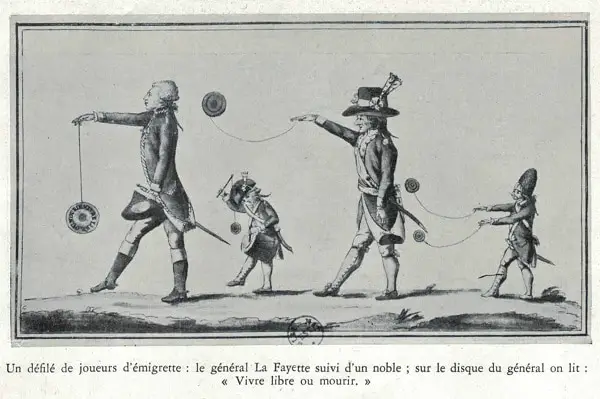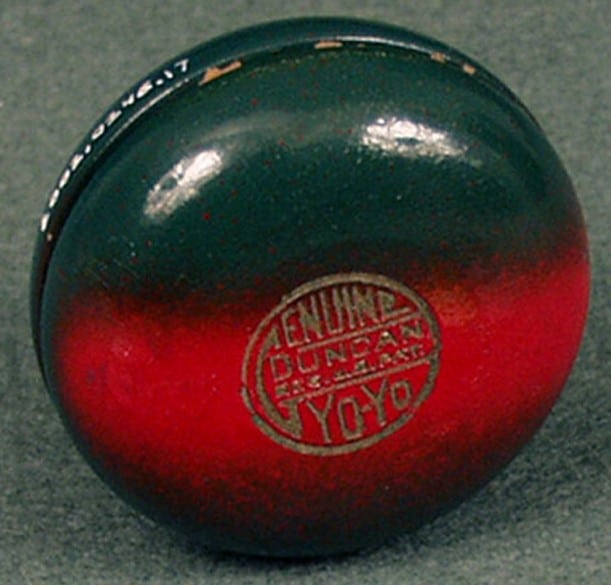We all have fond memories of playing with toys as kids. And one of the best ways to go back and remember those times is to view a video on Youtube that takes you on a virtual trip back into your childhood. But do you know when was the yoyo invented?
It’s not known exactly when the yoyo was invented. And while the general consensus is that it probably originated in China, the first time a yo-yo is mentioned is in Greece in 500 B.C.E. Made out of metal, painted terra cotta disks, or wood, these ancient toys were not originally called yo-yos, but rather just discs.
When children became of age, it was customary for the toys of their youth to be offered up to certain gods. It seems likely that the discs of terra cotta (a type of clay) were probably used for this purpose, as they would have been too fragile to actually use.
A vase that dates from around 500 B.C.E. shows a Greek youth playing with a yoyo, and such artifacts can be found in the National Museum of Athens in Greece.
When was the yoyo invented? The brief history
In the 16th century, there are historical records that show hunters in the Philippines using a yo-yo-like device while hunting.
They would hide up trees and tie a rock to a 20-foot-long cord. This would then be thrown at animals beneath them.
The cord gave the hunters the ability to have multiple attempts at their prey.
But of course, the idea that this is the true proto-yo-yo is a bit of a stretch.
All it really does tell us is that not only did the yo-yo travel from China to Greece, but it also traveled to the Philippines.
A country where the yo-yo is well known to be a popular toy for children.
After the 16th century, the next time there’s historical mention of the yoyo is India in the 18th century. Specifically, 1765.
There was a miniature box with a hand-painted picture of a girl wearing a red dress playing with her yo-yo.
Different names of the yoyo over time
Over the next 25 years, the yo-yo traveled from the Orient to Europe. It was found mostly in the upper-class societies of Scotland and France before finding its way to England.
As the yo-yo traveled from continent to continent it came to be known by many different names.
For example: in 1798, there was a French painting that showed the future King Louis XVII, age four, holding his l’emigrette.
Now, while this word literally means “leave the country” it become a nickname for the yoyo.

Why?
1789 was during the time of the French Revolution, and what has come to be known as the Reign of Terror.
Many of the French Aristocracy had to flee to Paris when their lives were threatened by the peasant uprisings. And when the aristocracy fled, they took their l’emigrettes made of ivory and glass with them.
Also read:
Here’s a List of 30 Inventions in the 1800s [Inventors Included]
Another nickname for the yoyo was de Coblenz—a city that many of the French fled to during the revolution.
What these two nicknames—l’emigrette and de Coblenz—the show is the important connection, historically, between the French Revolution and the yo-yo.
The yoyo didn’t get to Paris until the early 1790s, as it becomes more common throughout France it was given the name joujou de Normandie.
It is espoused by some that this is the possible etymological root for the modern American name yo-yo.
When the yo-yo craze made its way to England (late 18th century), they referred to it by a few different names: Bangalore, quiz, and incroyable (a term which means a French dandy).
The other name they were given was the Prince of Wales, because of the prince’s power to sell, and the toy’s popularity.
It wasn’t until 1866 that there was any mention of the yo-yo in America.
Two Ohio men received a patent for their invention called the improved bandalore—the improvement was that the rim was weighted.
Yoyo as stress relief
For the French nobility, the l’emigrette was just a fashionable toy. However, for the less fortunate, it has been conjectured that it was, in fact, a stress reliever.
Something to reduce the obvious tension of their one-way trip to the guillotine.
Throughout the 1780s there are drawings of persons such as General Lafayette and troops using their yoyos.
Even Napoleon and his troops at the Battle of Waterloo in 1815 were known to relax before the battle with their yoyos.
Who invented the yoyo?
What we today think of yo-yo, was invented in the Philippines. The natives have become experts at both making and using toy.
Carved from wood, children from a very early age were playing with yo-yos, and the overall popularity of the toy makes it a national pastime.
In 1920, Pedro Flores went to America, taking with him the first Filipino yo-yo. In 1928 Flores started a yo-yo company, called Yo-yo in California.
Flores’s yo-yos were hand-carved from a single piece of wood and were unique from previous designs.
Their unique quality was that the string wasn’t tied to the axle. Rather, the string looped around the axle enabling it to spin at the end of the string.
This concept is central to ”yo-yoing” today. It meant the yo-yo no longer only goes up and down but would be capable of a wide variety of tricks.
Sometime between 1928 and 1929, Donald Duncan Sr. saw his first Flores yo-yo during a trip to San Francisco.
When he saw the crowd, Flores was drawing with a few simple tricks, he could tell the enormous commercial value of this toy.
Duncan Sr. bought not only the idea for the idea, but he also bought Flores’s company.

By 1946, Duncan Sr.’s company was producing some 3,600 yo-yos an hour.
The company used over 1,000,000 board feet a year producing the original maple wooden toys.
It wasn’t until 1960 that plastic yo-yos, the sort your see today, started to be manufactured.
The yoyo today
Since Duncan Sr.’s day, the yo-yo has evolved greatly. There have been developments in size, axle type, shape, and material.
The shape of a yo-yo can play a role in the type of tricks a yo-yo is able to do.
There are three shapes: the imperial (Duncan Sr.’s design), the butterfly, and the modified.
The butterfly yo-yo is the most common shape. It makes even the most complicated string trick possible and has changed the way yo-yo tricks are performed.
Four of the five styles performed at the world yo-yo contest are performed with the butterfly yo-yo
The modified yo-yo was common in the Playmaxx era—and was one of the greatest selling yo-yos in history.
The slightly curved edge of the yo-yos inner wall makes more tricks possible by reducing the friction on the string.
Some yo-yo contests do use this shape, such as the Yoyofactory Loop 1080.
Many people think of a yo-yo, the shape that comes to mind is imperial. However, this is actually the least used of the yo-yos today.
This shape of the yo-yo is great for people learning basic control and tricks.
These yo-yos are thought of as being beneficial for beginners but have no place in competitions as they aren’t able to do string tricks like other yo-yo shapes.
Yo-yos are the number two best-selling toy in history; it is also one of the oldest, with a 2,500-year history.
It’s safe to say the yo-yo will continue to be around for a long time to come.
Final thoughts
I hope you enjoyed this detailed look at the history of the yoyo. From its humble beginnings as a children’s toy carved from wood to what it is today.
Please leave your questions or thoughts in the comments below.
Now that you know when was the yoyo invented, was it earlier or sooner than you thought?
Thanks for reading!

